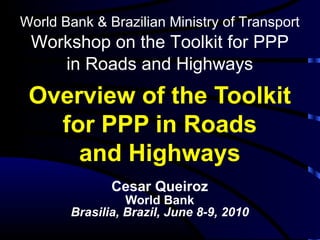Overview Toolkt Pp Phwys Bsb Jun2010 C Queiroz V3
- 1. Overview of the Toolkit for PPP in Roads and Highways C e sar Queiroz World Bank Brasilia, Brazil, June 8-9, 2010 World Bank & Brazilian Ministry of Transport Workshop on the Toolkit for PPP in Roads and Highways
- 2. Presentation Outline Toolkit objectives Toolkit uses Six modules of the Toolkit Models for financial assessment of highway PPP/concession projects Discussions
- 3. Objectives of the Toolkit To assist transport sector policy makers in developing countries in implementing procedures to promote private sector participation and financing in roads. To serve as a manual for World Bank clients and staff when they recommend and implement processes to increase private participation in roads. Supported by Public-Private Infrastructure Advisory Facility (PPIAF)
- 4. Uses of the Toolkit Assists in each stage of PPP preparation by defining objectives and components (including Terms of Reference) Describes the PPP framework necessary to develop private sector interest Presents “most applicable practices” comprising those most suited to developing countries Helps practitioners to understand PPP Helps teaching PPP/concessions in highways
- 5. The Toolkit as a Manual Helps fill the gap knowledge to develop PPPs Instead of a “PPP dogma,” provides a more pragmatic approach of “where and under what conditions can PPP be appropriate?” Self-contained on CD-ROM and Internet: http://go.worldbank.org/P2XMGNYLD0
- 6. Content of Toolkit Six Modules (core subjects): Overview and diagnosis: PPP strategy Key components: characteristics of PPP projects Policy and planning: role of the public sector Laws and contracts: contract bases for PPP Implementation and monitoring: stages to implement PPP Tools: case studies, financial models, bibliography, PDF version Additional Tools Site map, Glossary, Abbreviations, Search
- 9. The 2009 vs. 2001 Versions Updated practices since 2001 Improvement of user-friendliness Complete contract cycle, including identification, feasibility, procurement, contract award, and contract management (including renegotiation) Upgraded and audited financial models
- 10. Continuum of Alternatives The Toolkit presents a broad definition of PPP including performance-based contracts http://www.ppiaf.org/documents/toolkits/highwaystoolkit/1/1-13.html
- 11. Why enable PPPs? 90% of investment in PPP since 1990 has been concentrated in only 10 countries 117 developing countries did not receive any private investment at all in the highway sector Source: World Bank/PPIAF PPI database
- 12. Why PPP? The real issue for PPP is not public infrastructure versus private infrastructure. It is more simple; the issue is less infrastructure versus more. Harris, 2003
- 13. Enabling Environment for PPP Public sector commitment: Stable economy, public funding support Capable public and private sectors: Effective partnership, protection of public interest Effective risk management: Maximum benefits from PPP Favorable investor climate: Ensures private funding. Private sector's raison d'ĂŞtre is about taking risks and making profit http://www.ppiaf.org/documents/toolkits/highwaystoolkit/1/1-43.html
- 14. Lessons learned from existing programs Need of full commitment across the ministries involved Projects are often insufficiently prepared with inappropriate risk management/allocation Relatively minor defects in bidding documents can lead to weak competition Inconsistent laws and regulations can be worse than limited or no laws, where regulation by contract can work Unsolicited bids may undermine governance and often take longer than competitive bidding A properly developed pipeline of projects is essential Consultation and explanation of PPP projects is vital IFIs and qualified advisors can help
- 15. Toolkit Financial Models Purpose Familiarization of non-financial specialists with the basics of project finance and financial simulations for a (highway) PPP project Better understanding of key parameters which affect the financial viability of a PPP project Preliminary scrutiny of PPP projects Limits Simplified financial models: graphical and numerical versions Specific project assessment requires detailed financial models prepared by experienced financial practitioners
- 16. The model represents the main financial features of a project company in graphic form and their sensitivity to a range of 14 key assumptions The graphs change according to the key project assumptions Cash Flow graph Debt graph Dividends graph Link to financial models Toolkit > Tools > Financial models Graphical Model
- 17. The model provides financial statements by a potential concessionaire to analyze the construction and operation of a highway concession under a Build-Operate-Transfer (BOT) scheme The Assumptions sheet of the model contains all the key parameters and data input as determined by the user The financial model is not a banking model and is not intended to provide project-specific financial modeling Numerical Model
- 18. Main Stages to Launch a PPP Project Stage 1: Identification, Prioritization and Selection of the PPP Project Stage 2: Due Diligence and Feasibility Studies: includes activities and studies to ensure the selected project is well designed and can be successfully tendered and implemented Stage 3: Procurement: includes prequalification of bidders and the bidding and bid evaluation process, and a section on Unsolicited Bids Stage 4: Contract Award: gives advice on dealing with the preferred bidder(s) Stage 5: Contract Management: deals with the construction and operation periods of a project including transfer back if relevant – BOT, but not BOO
- 19. Some Key PPP Features Length of the concession contract: usually between 5 and 60 years Partial or total private funding of public infrastructure Sharing of risks and revenues between public and private sectors – risk allocated to party best able to manage it
- 20. Allocation of Risks Traditional Outsourcing High RISK TO PUBLIC SECTOR Low RISK TO PRIVATE SECTOR High Performance-based Contracts Decreasing Public Risks, Increasing Private Risks BOO Availability Payments Toll Road BOT Shadow Tolls
- 21. Ěý
- 22. Thank you!
- 23. Cesar Queiroz Roads and Transport Infrastructure Consultant Tel +1 202-473 8053 Cell +1 301 755 7591 [email_address] [email_address]
- 24. Toolkit Case Studies Brazil – country case Chile – concessions in Santiago Croatia – A6 motorway France – country case Hungary - M1/M15 motorway India – country case Korea – country case Serbia – country case South Africa/Mozambique N4 toll road UK – M6 toll road US – country case Zambia – PBC contracts Indonesia – country






















![Cesar Queiroz Roads and Transport Infrastructure Consultant Tel +1 202-473 8053 Cell +1 301 755 7591 [email_address] [email_address]](https://image.slidesharecdn.com/overviewtoolktppphwysbsbjun2010cqueirozv3-12769543148325-phpapp02/85/Overview-Toolkt-Pp-Phwys-Bsb-Jun2010-C-Queiroz-V3-23-320.jpg)
